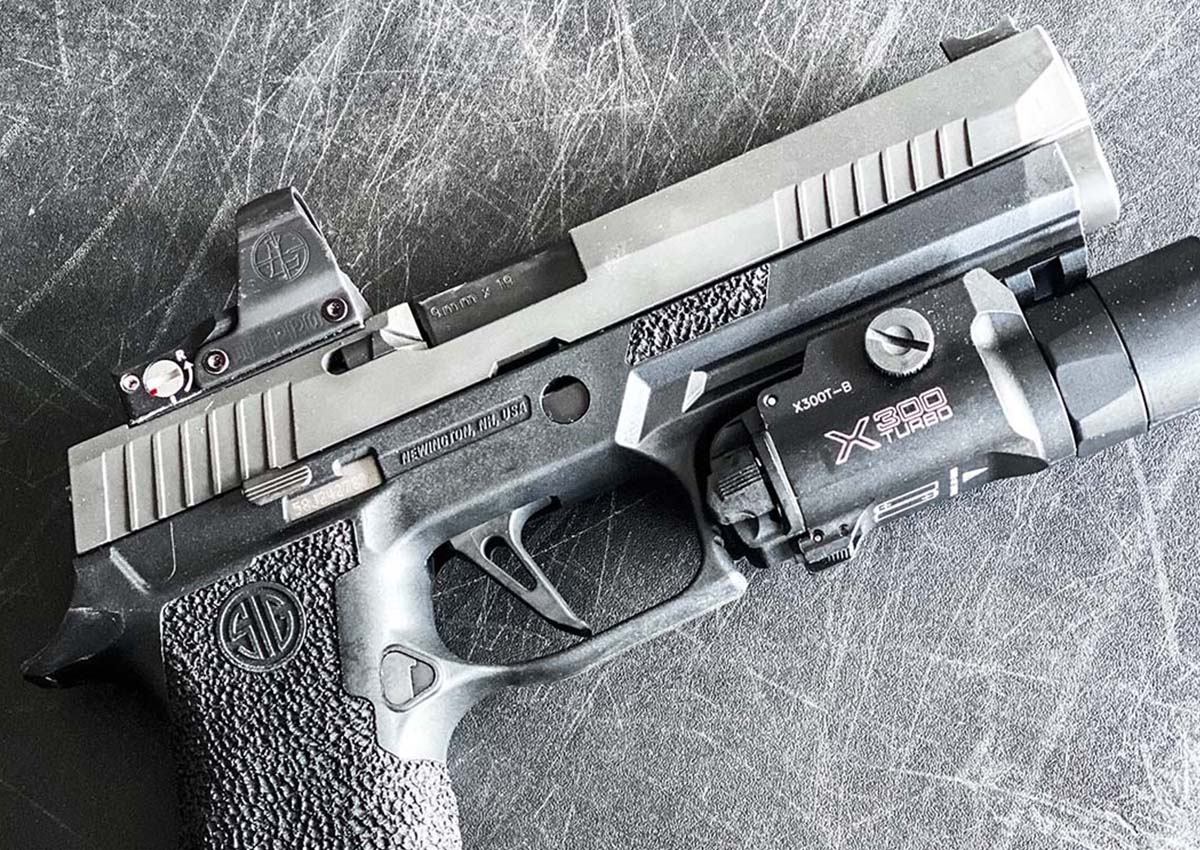Best .308 Ammo for Hunting, Tested and Reviewed

We may earn revenue from the products available on this page and participate in affiliate programs. Learn More ›
The .308 Winchester remains an incredibly popular cartridge in 2025 and picking the best .308 ammo for hunting might seem overwhelming. There are lots of great options. Over the past several years, The Outdoor Life gun crew has been shooting and testing many different makes and types of .308 ammo while tackling gun tests and rifle reviews. Though we can’t always get our hands on everything, if you’re looking to choose the best .308 ammo for hunting — especially the hunting you do, use our experience and this guide to help you.
Things to Consider Before Buying .308 Ammo for Hunting
Here are some key things to consider when shopping for .308 hunting ammo:
Game and Bullet Construction
As with any hunting ammo, you want to choose a load and bullet that will suit the game you intend on hunting. The .308 Win. is an extremely capable (and somewhat underrated) cartridge. It’s perfectly suitable for large game like elk, moose, and even brown bears. If you’re hunting heavy game, pick a heavy, bonded, or monolithic bullet and keep your shot distances under 300 yards. Most people are hunting medium-sized game with the .308 and just about any medium-weight expanding bullet will do. Luckily there’s plenty of good, affordable .308 ammo for deer that can be found on store shelves or delivered to your doorstep.
Accuracy
At Outdoor Life, we strive to present you with the best, most useful accuracy data possible. For many years, we leaned on averages of five-shot groups for this. Though we still shoot five-shot groups and present that data — that’s what most of us are calibrated to interpret — we have found that it really doesn’t give you an accurate representation of what to expect from a rifle — the sample size is too small. Group sizes vary too much to be definitive. We have started compiling our groups into 20-shot aggregate groups using the method described in this story, A Better Way to Zero Your Rifle, and that gives us consistent, repeatable expectations for a rifle and ammo. We also present Mean Radius, which is the average distance by which each shot misses the center of the group. This metric takes every shot into account, not only the worst two.
We have tested all of this ammo in a variety of hunting rifles, but most of the data you will see is from a control rifle I built specifically for accuracy testing and evaluation. It’s a Zermatt Arms TL3 short action with a competition-contour Proof Research steel barrel, in an MDT stock. Through this rifle, most ammunition will perform better than in the average hunting rifle. Ammunition that was tested previously through a variety of hunting rifles, but not the Zermatt, will show average five-shot group size data and be updated as it’s tested more extensively.
Cost
Ammo is expensive, and premium ammo is even more expensive. If you need top-end bullet construction or are shooting at distances that require best-in-class accuracy, it’s worth the extra cost. However, if you’re hunting deer-sized game at distances under 200 yards or so, less-expensive ammo is usually sufficient.
Reviews and Recommendations:
Federal Fusion Tipped 180-grain
See It
Pros
- Excellent accuracy
- Great terminal performance
- Good B.C.
- Great value
Cons
- More expensive than regular Fusion
Award: Best All-Around .308 Hunting Ammo
Average 5-Shot Group Size: .68 inches
20-shot Group Size: .93 inches
Mean Radius: .28 inches
Key Features
- 180-grain bonded ballistic-tip bullet
- Lead core, copper jacket
- G1 B.C.: .501
- Velocity: 2600 fps
- Price per box: $53
Federal’s new Tipped Fusion lineup is one for any hunter to keep an eye on. We have long felt like the regular fusion line is highly underrated — especially for deer hunting — and we have been very happy with the Fusion Tipped ammo in every caliber we’ve tried it in. It’s more affordable than some of the premium loads and, in our experience, has been more accurate. In .308, it’s offered in a 180-grain tipped bonded bullet with a good B.C. Federal has the BC listed as lower than that of the regular 180-grain Fusion .308 bullet, but we believe that to be an error.
This .308 hunting ammo is the best-shooting stuff that I have tested, and a sub-inch 20-shot aggregate group is not a common thing. It’s easy to determine that this is some of the best all-around .308 ammo for hunting that you can buy today. In addition to its accuracy and affordability, bullet weight and performance should give you confidence on just about any North American game — and most game animals in the world.
Federal Fusion 180-grain Bonded Soft Point

See It
Pros
- Reliable expansion
- Great accuracy
- Affordable
Award: Best .308 Ammo for Deer
Average 5-Shot Group Size: .98 inches
20-shot Group Size: 1.29 inches
Mean Radius: .39 inches
Key Features
- 180-grain Bonded soft-point bullet
- Lead core, copper jacket, skived tip
- G1 B.C.: .503
- Velocity: 2600 fps
- Price per box: $37
Some of the most underrated .308 ammo for hunting is Federal Fusion — and it’s some of the best deer hunting ammo you can buy. In this offering, it has a 180-grain lead-tipped bullet that has a bonded jacket. Federal Fusion ammo is designed to expand rapidly and consistently, but maintain mass for deep penetration. It’s not part of their premium lineup, but across a lot of calibers, it’s a great value and solid choice.
We have found Federal Fusion to be more accurate than a lot of premium ammo, and available at very reasonable prices. The soft-pointed version doesn’t have a slippery ballistic coefficient, but for deer hunters who will generally be shooting less than 300 yards, it doesn’t get much better.
Hornady Outfitter 165-grain CX

See It
Pros
- High weight-retention
- Nickel-plated cases for smooth cycling
- Sealed case mouth and primer for additional weather protection
Cons
- Accuracy is poor in rifles tested
Award: Best Copper .308 Ammo
Average 5-Shot Group Size: .92 inches
20-Shot Group Size: 1.3 inches
Mean Radius: .39 inches
Key Features
- Copper alloy construction with polymer tip
- Relief grooves in bullet
- Nickel-plated cases
- G1 B.C.: .440
- Velocity: 2610 fps
- Price per box: $43
Hornady’s Outfitter line is designed for hard use in inclement weather conditions, and uses their latest mono-metal bullet, the CX. Like Hornady’s previous iteration—the GMX—the CX is a controlled expansion, high weight-retention copper bullet with a ballistic tip, relief grooves, and a boat tail. It’s ideal for both medium and large-sized game out to about 300 yards. Beyond that, it drops below 2,000 feet per second, and expansion will diminish.
This ammo comes loaded in nickel-plated cases with both the case mouth and primer sealed to prevent any stubborn moisture from contaminating the powder. In addition to corrosion protection, the nickel plating is a harder surface that provides smoother loading and cycling.
I’m a believer in the penetration effectiveness of mono-metal bullets like the CX, and in a brush bullets test I conducted a couple years back, they proved to be much less prone to deflection than lead-core bullets of similar shape. Their performance on game is also excellent. Accuracy can sometimes be an issue though, and some of the rifles I tested really cared for this Outfitter load. In my Zermatt TL3 test rifle, accuracy was the best of any factory-loaded copper bullets I tried.
Barnes Vor-Tx 168-grain TTSX

See It
Pros
- Consistent expansion
- Excellent weight retention and penetration
- Accurate
- Lead-free
Cons
- Expensive
- Availability varies
Average 5-Shot Group Size: 1.95 inches
Key Features
- 168-grain TTSX boattail
- Double-diameter expansion
- G1 B.C.: .470
- Velocity: 2700 fps
- Price per box: $56
Barnes has long been an industry leader in monolithic copper bullets, and their TTSX is one of the best on the market. Loaded in their factory Vor-Tx .308 ammo, the 168-grain TTSX is an excellent choice for just about any game. In-fact, a friend of mine who lives on Kodiak uses it for everything (including brown bears).
The TTSX bullet is copper with a blue polymer ballistic tip that helps initiate expansion. Typically, these bullets expand into an X-shape with almost 100 percent weight retention and deep penetration. The TTSX certainly has some challengers, but it’s the standard that all other copper bullets are measured against.
Some rifles can be finicky with copper bullets, but this .308 ammo is generally accurate overall in a variety of rifles. Some like it, some just shoot it OK, but none seem to shoot it poorly. It’s a great option for .308 deer ammo but can also tackle bigger game.
Remington 150-grain Core-Lokt Tipped

See It
Pros
- Good accuracy across the board
- Dependable expansion and weight retention
- Shoots consistently in many different rifles
- Excellent all-around hunting bullet
Cons
- More expensive than original Core-Lokt
Average 5-Shot Group Size: .97 inches
20-Shot Group Size: 1.55 inches
Mean Radius: .42 inches
Key Features
- 150-grain polymer-tipped bullet
- Jacket and core are mechanically fastened
- G1 B.C.: .415
- Velocity: 2840 fps
- Price per box: $40
I first reviewed Remington’s Core-Lokt Tipped ammo a few years ago and wasn’t sure what to expect. This was, after all, one of Big Green’s first post-bankruptcy launches. I found that the green-tipped bullets shot well in my .30/06 and performed well on a caribou. How would the load do in .308 Win. though?
The bullet is a boat-tailed projectile with a core that’s held together by a rib on the jacket. It’s tipped with a green-polymer nose and has a thin jacket up front that promotes expansion—much like the original Core-Lokt. The 150-grain bullet doesn’t have a remarkable B.C., but it’s better than its lead-tipped counterparts.
Accuracy of this .308 ammo was good in several rifles, but what was most impressive was that it has shot pretty well in almost every rifle I’ve tested it in. One of my buddies even took a nice bull moose with it, with the bullet passing through on a broadside shot. This ammo is a good balance of affordability, precision, and effectiveness.
Nosler Whitetail Country 165-grain Soft Point

See It
Pros
- Affordable
- Good deer ammo
- controlled expansion
Average 5-Shot Group Size: 1.79 inches
20-Shot Group Size: 2.47 inches
Mean Radius: .73 inches
Key Features
- 165-grain boat tailed soft point
- Lead point to initiate expansion
- G1 B.C.: .442
- Velocity: 2,800 fps
- Price per box: $35
Late in 2024, Nosler introduced their Whitetail Country line, ammo that’s designed to be more affordable for the average deer hunter that is using it at shorter distances. The bullet in .308 is a 165-grain soft point that is essentially Nosler’s ballistic tip bullet with a lead tip. It has a boat talk rear and a tapered jacket to control expansion. It’s simply an affordable good deer-killing bullet.
In my test rifle, the .308 ammo did not shoot well, but I had a limited quantity and couldn’t test in other guns. the 6.5 Creedmoor loads I tried in the Whitetail Country shot really well in another Proof-barreled gun, with an impressive 20-shot group size of 1.08 inches, and 1.47-inches in a Browning X-Bolt. Ultimately, this ammo serves its purpose well and is more affordable than most other .308 ammo for hunting.
Federal Premium 175-grain Terminal Ascent

See It
Pros
- Expansion at low velocity
- Bonded core for good weight retention
- Good accuracy and high B.C.
- Nickel-plated brass
Cons
- Expensive
- Accuracy isn’t consistent across all rifles
Average 5-Shot Group Size: .86 inches
20-Shot Group Size: 1.34 inches
Mean Radius: .4 inches
Key Features
- 175-grain bonded, High-B.C. bullet
- Hollow ballistic tip initiates low-velocity expansion
- G1 B.C.: .520
- Velocity: 2600 fps
- Price per box: $48
Federal Premium’s Terminal ascent bullet and load are designed to deliver accuracy and terminal performance at long or short distances. This 175-grain bullet features a bonded core and hollow “slipstream” ballistic tip that helps initiate expansion at lower velocities. The bullet also has relief grooves like those on monolithic copper bullets, and a long boat tail. The nickel-plated cases feed and extract reliably, and the quality of components is good.
I found the Terminal Ascent to yield somewhat mixed accuracy results, depending on the rifle. Some rifles shot it well, others didn’t. In the Christensen Ridgeline Titanium that I reviewed, this .308 ammo shot well, and I was able to reliably make first-round hits out to 600 yards. It also shot pretty well in my Zermatt TL3 test rifle, but not as well as some other loads.
If you’re hunting larger game like elk, or might be shooting beyond 300 yards, this load is an excellent option (assuming your rifle likes it). A bullet with a good B.C. like this will give you a better trajectory and buck the wind better than other bullets. Because it will still expand at lower velocities, it has an edge over some copper and other bonded bullets—especially in the relatively slow .308 Win.
Hornady Superformance 150-grain SST

See It
Pros
- High velocity
- Good expansion and weight retention
- Low accuracy deviation
Cons
- Not exceptionally accurate in any single rifle
Average 5-Shot Group Size: 1.88 inches
Key Features
- 150-grain mechanically bonded ballistic tip
- Proprietary propellant delivers best-in-class velocity
- G1 B.C.: .447
- Velocity: 3000 fps
- Price per box: $40
Product Description
Hornady’s Superformance line is still on the shelves in .308 ammo, and its biggest selling point is speed. The powder used delivers a couple hundred extra feet per second of velocity without dramatic pressure increases compared to other commercial loads. Topped with a 150-grain SST at 3,000 feet per second, it’s a great option for medium-sized game and hunters who prefer to sight in using the maximum point-blank method rather than turrets or holdover reticles.
The 150-grain SST bullet is a simple but effective boat-tail-based, cup and core bullet, but the jacket is mechanically fastened to the core for weight retention. The polymer tip helps make it more aerodynamic and initiates expansion. It might not be as deep-penetrating as heavier bonded or monolithic bullets, but it would be ideal for deer, black bears, and caribou. It would work just fine on heavier animals such as elk and moose.
Although accuracy in my testing wasn’t bad, it wasn’t great. There weren’t any rifles with which the load really stood out. However, the standard deviation of the group size was pretty small, so you could reasonably expect this ammo to shoot well in most rifles.
Federal Premium 180-grain Trophy Bonded Tip

See It
Pros
- Reliable expansion
- High B.C.
- Heavy-duty bonding for weight retention
- Nickel-plating for smooth loading and cycling
Cons
- Mediocre accuracy in test rifles
Average Group Size: 1.93 inches
Key Features
- Bonded core and jacket
- Skived jacket for reliable expansion
- G1 B.C.: .500
- Velocity: 2620 fps
- Price per box: $45
The Trophy Bonded Tip bullet is a tough but streamlined projectile that’s meant for heavy use. The 180-grain .308 Win. load is a potent one, and appropriate for just about any game in North America. It’s only 80 feet per second slower than the .30/06 load with the same bullet, and most animals would never know the difference.
In addition to the bonded jacket and core, the bullet has a polymer tip that aids with consistent expansion, as does the scored jacket. Relief grooves and a boat tail give the bullet a good B.C., but its strength is in shooting tough game at closer distances. The nickel-plated cases and bullets help them load, chamber, and eject smoothly, and it uses Federal Gold Medal primers.
Accuracy of this .308 ammo was mediocre in my test rifles, but it was relatively consistent. It is noticeable that the nickel-plated cases load and cycle more smoothly, and it is excellent ammo for hunting larger game. Its strength isn’t long-range hunting, but were I taking a .308 after moose, elk, or grizzly bears, this is a great load to use.
Federal Premium 178-grain ELD-X

See It
Pros
- Good expansion and weight retention at .308 velocities
- Good B.C. for longer distance shooting
- Heat-shield polymer ballistic tip
Average 5-Shot Group Size: 1.76 inches
20-Shot Group Size: 2.01 inches
Mean Radius: .62 inches
Key Features
- 178-grain ELD-X bullet
- Mechanically fastened core with heat-shield ballistic tip
- Controlled expansion at low velocities
- G1 B.C. .552
- Velocity: 2610 fps
- Price per box: $46
Recently, Federal started loading Hornady’s popular ELD-X hunting bullets in it’s premium line, and for good reason. The ELD-X is a great-shooting bullet that offers effective performance across a wide range of impact velocities. Up close, you’ll see massive expansion and wound cavity, out farther, the ELD-X will retain most of its weight and penetrate deeply. It’s an excellent all-around hunting bullet and ideal for longer distances in .308 ammo. At .308 velocities this will be a great choice for just about any North American game.
This load was pretty disappointing in my Zermatt test rifle, but seemed to do better in other hunting rifles I shot samples in. Results will likely vary for you. As you should with any ammo, test a box of it before buying in bulk.
FAQ’s
There are lots of excellent options for .308 deer ammo, and all the loads covered in this test would work well. If you’re on a tight budget, the Federal Non-Typical Whitetail or Winchester Deer Season XP would be the go-to. Otherwise, go with the Remington Core-Lokt Tipped.
If you’re hunting at longer distances, you want a high-B.C. bullet that is accurate in your rifle and designed to expand at lower velocities. The .308 isn’t a hard-hitting cartridge at distance, but it can perform with the right bullet. Federal Premium 175-grain Terminal Ascent or Swift Scirocco II loads would be good ones to use.
Elk are big, tough animals, and the most important factors in killing them cleanly are shot placement and bullet construction. Bullets that will expand but maintain their weight are usually the best choice, and the Barnes TTSX or Federal Premium Trophy Bonded Tip would both be great options.
The most accurate .308 hunting ammo that we have tested is Federal’s Fusion Tipped 180-grain.
Final Thoughts on .308 Hunting Ammo
We often celebrate the merits of new cartridges, but the .308 Winchester isn’t going anywhere anytime soon. It’s still an excellent choice for any hunter, and the .308 is capable of taking any game in North America. We will continue to test the best .308 ammo for hunting that we can get our hands on, and provide you with the best data and honest feedback that we can.
Read the full article here







